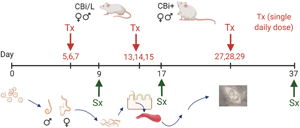Article contents
Effect of sex and genotype of the host on the anthelmintic efficacy of albendazole microcrystals, in the CBi-IGE Trichinella infection murine model
Published online by Cambridge University Press: 07 July 2021
Abstract

Albendazole (ABZ) is an anthelmintic pharmaceutical commonly used in the treatment of nematode infections. It is a Class II drug poorly water-soluble, with very low bioavailability, a feature particularly limiting to treat the trichinellosis chronic phase. Microcrystals obtained by controlled precipitation using hydroxyethyl cellulose and chitosan have previously been shown to improve ABZ biopharmaceutical properties. This investigation aimed to test the systems' in vivo efficacy in the CBi-IGE murine model of Trichinella spiralis infection in the infection's different phases and parasite’ stages. Treatment in the enteral phase led to a 90% decrease in the larval muscle load, probably due to its effect on T. spiralis female fecundity. Both microcrystal systems given in the migratory phase halved muscle load in males, a response not observed in females. The chitosan-based microcrystals proved to be the best when administered in the chronic phase of the infection – an increased proportion of L1 dead larvae was found compared to controls, except in CBi+-treated females. Males and females from the highly susceptible CBi+ line presented a significantly different treatment response in this phase. In vivo efficacy depended on the host genotype and sex and was related to the parasite cycle stage in which the formulations were administered.
Keywords
- Type
- Research Article
- Information
- Copyright
- Copyright © The Author(s), 2021. Published by Cambridge University Press
Footnotes
Contributed equally to this work.
Current address: Department of Bioengineering and Therapeutic Sciences, University of California San Francisco, 1550 4th Street, San Francisco, CA 94143, USA.
Joint senior authors.
References
- 2
- Cited by





